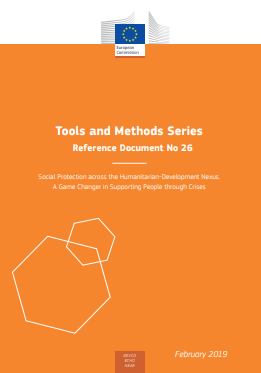Social protection across the humanitarian-development nexus: A game changer in supporting people through crises (SPaN)
This 'Reference Document' and its 'Summary' were produced as parts of the European Commission’s ''Guidance Package on social protection across the humanitarian-development nexus'' (SPaN). It is a common product of an initiative jointly led by the European Commission’s Directorate-General for International Partnerships (INTPA, former DEVCO), Directorate-General for European Civil Protection and Humanitarian Aid Operations (ECHO) and the former Directorate-General for Neighbourhood and Enlargement Negotiations (NEAR).
As part of the Guidance Package, an e-learning course available at INTPA Academy since 2020. It introduces modules based on this Reference Document, reflecting knowledge from SPaN's resources.
This reference document aims to:
- Articulate what is meant by working with social protection systems and approaches in crisis contexts;
- Provide an overview of global experience and approaches to date;
- Highlight specific challenges and suggest key criteria to inform decisions as to the most appropriate response option;
- Provide guidance on key issues to consider when working with social protection in crisis contexts;
- Highlight key features of social protection-related interventions in crisis contexts and offer practical tips;
- Identify outstanding questions to inform future research.
The Reference Document contains the following chapters:
CHAPTER A presents a brief overview of social protection, including the instruments dealt with in this paper. It sets out the similarities and differences between social protection and humanitarian action.
CHAPTER B outlines some of the well-established impacts of social protection programmes and approaches across a range of outcomes. It provides an overview of the major reasons why there is growing interest in working with social protection systems and approaches in crisis contexts. It sets out an evidence-based rebuttal to some common concerns about working with social protection in crisis contexts.
CHAPTER C highlights how social protection instruments can and have been used in crisis contexts. It presents a typology for understanding different types of responses to date, followed by an outline of the challenges. It offers a comparison of the pros and cons of different social protection instruments in crisis contexts and a comparison of social transfer response approaches. Finally, it provides a framework for assessing different response options.
CHAPTER D introduces the important features of social protection systems and approaches in crisis contexts that reflect currently promising practices.
CHAPTER E highlights a number of research and operational questions in relation to this topic that still need to be answered.
ANNEXES contain complementary resources, including in particular a glossary of key terms used in this paper, a list of relevant policy commitments, three case studies of responses in different crisis contexts, and a selection of further tools and resources
The Supplementary Volume of Operational Notes is an integral part of this Reference Document. It provides ten operational notes on the following topics: Benefit Modalities, Targeting, Stakeholders, Operations, Integrated Financing, Health and Education, Nutrition Security, Vulnerable Groups, Fragility and Forced Displacement.
Other SPaN resources include country case studies, an e-learning journey, and Think Pieces with new Think Pieces added in 2023 that draw on the experiences of the EU programme ‘Improving Synergies between Social Protection and Public Finance Management’ (SP-PFM), which was implemented jointly by the International Labour Organization (ILO), UNICEF, and the Global Coalition for Social Protection Floors (GCSPF). The lessons are relevant for development and humanitarian partners and government officials working in social protection and disaster risk management.

Log in with your EU Login account to post or comment on the platform.